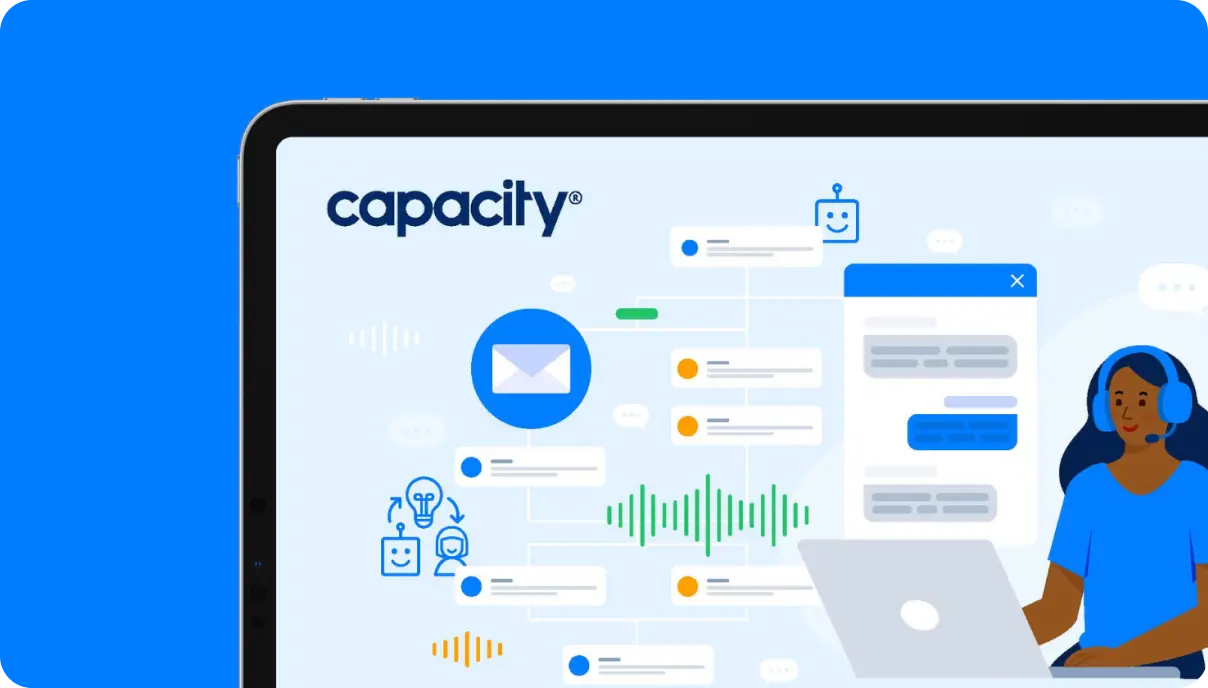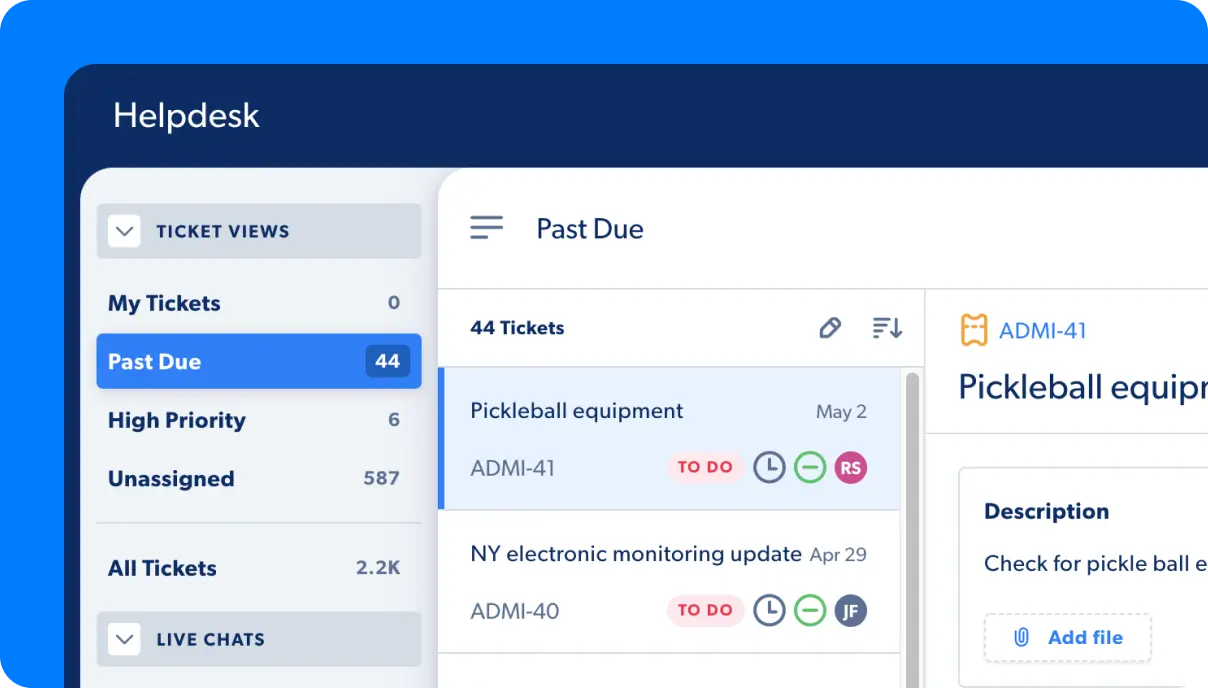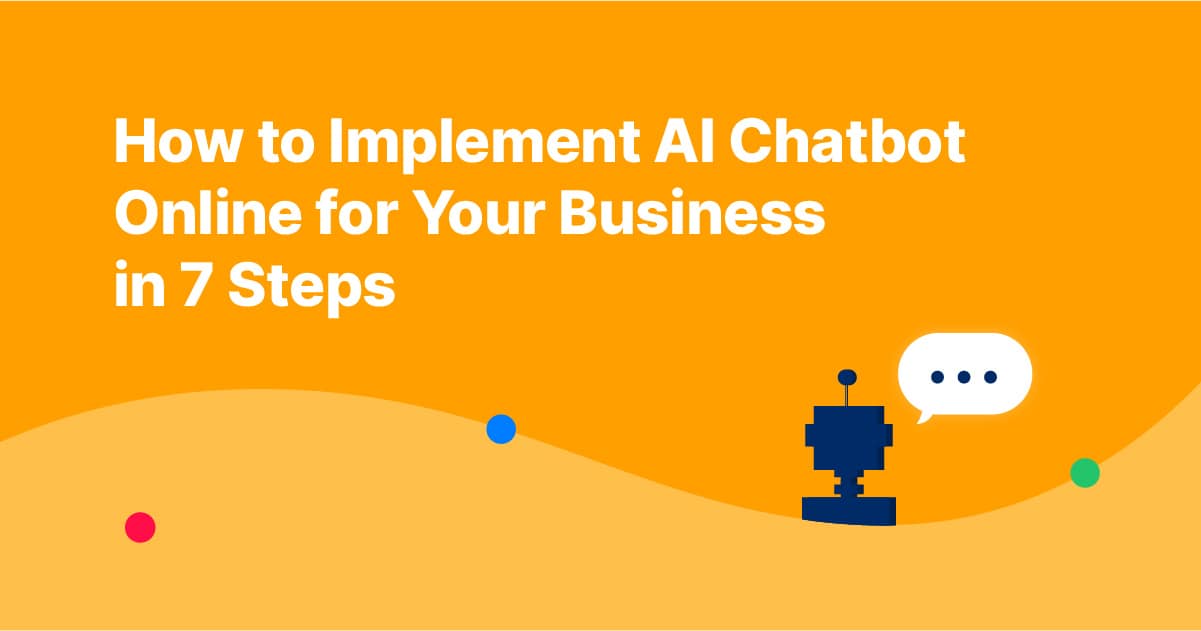Have you chatted with a robot lately? No, we’re not talking about R2D2 or C3PO from Star Wars. We’re talking about AI chatbots online. These talking machines are everywhere, from online customer support to social media messaging. But what’s the impact of this robotic revolution? Besides giving us a virtual assistant that doesn’t take vacations, AI chatbots have revolutionized how businesses interact with their customers, saving time and money.
In today’s fast-paced digital world, businesses constantly seek innovative ways to improve customer service and streamline operations. AI chatbots online have become increasingly popular among companies in the last few years. In this article, we will explore what an AI chatbot online is, the top benefits of using AI chatbots for businesses, the steps to implement an AI chatbot online, and some of the best AI chatbot online companies available in the market.
Let’s dive in!
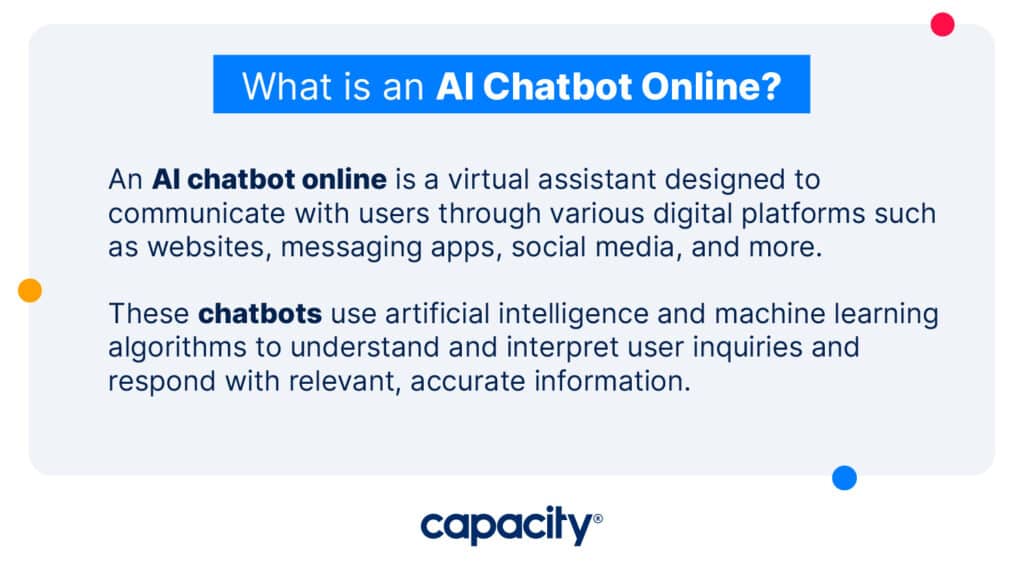
What is an AI Chatbot Online?
An AI chatbot online is a virtual assistant designed to communicate with users through various digital platforms such as websites, messaging apps, social media, and more.
These chatbots use artificial intelligence and machine learning algorithms to understand and interpret user inquiries and respond with relevant, accurate information. AI chatbots can be designed for various purposes, such as customer support, sales assistance, information retrieval, etc.
Online AI bots can handle multiple tasks, from answering frequently asked questions to providing personalized recommendations, making them a valuable asset for businesses looking to enhance their online presence and customer engagement.
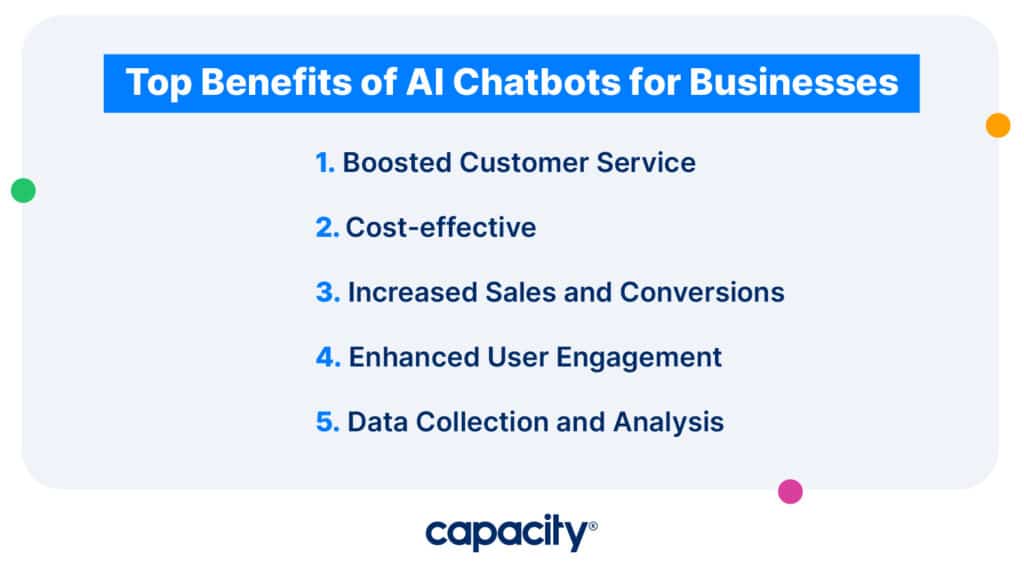
Top Benefits of AI Chatbots for Businesses
Here are the most significant benefits:
Boosted Customer Service
One of the main benefits of adding an AI chatbot online is improved customer service. AI chatbots are available 24/7 and can handle multiple inquiries simultaneously, providing instant responses to user queries. This ensures customers get quick and accurate assistance, enhancing customer satisfaction and loyalty.
Cost-effective
AI chatbots can help businesses save costs by automating repetitive tasks requiring human resources. By handling routine inquiries and tasks, AI chatbots can free human agents to focus on more complex issues, improving efficiency and productivity.
Increased Sales and Conversions
AI chatbots can be used as virtual sales assistants, guiding users through purchasing, providing product recommendations, and offering personalized promotions. This can increase sales and conversions, as AI chatbots can provide users with a personalized and seamless shopping experience.
Enhanced User Engagement
AI chatbots can engage users in interactive and personalized conversations, improving user engagement. By providing relevant information and assistance, AI chatbots can keep users engaged and interested in the discussion, leading to a higher likelihood of users returning for future interactions. Plus, an AI chatbot online can simplify the user experience, allowing customers or prospects to receive instant answers.
Data Collection and Analysis
AI chatbots can collect and analyze data from user interactions, providing valuable insights into user behavior, preferences, and needs. This data can be used to optimize business processes, improve products or services, and make informed business decisions.
Steps to Implement AI Chatbot Online
Once you’ve identified the need for an AI chatbot online, you can follow these steps to get up and running:
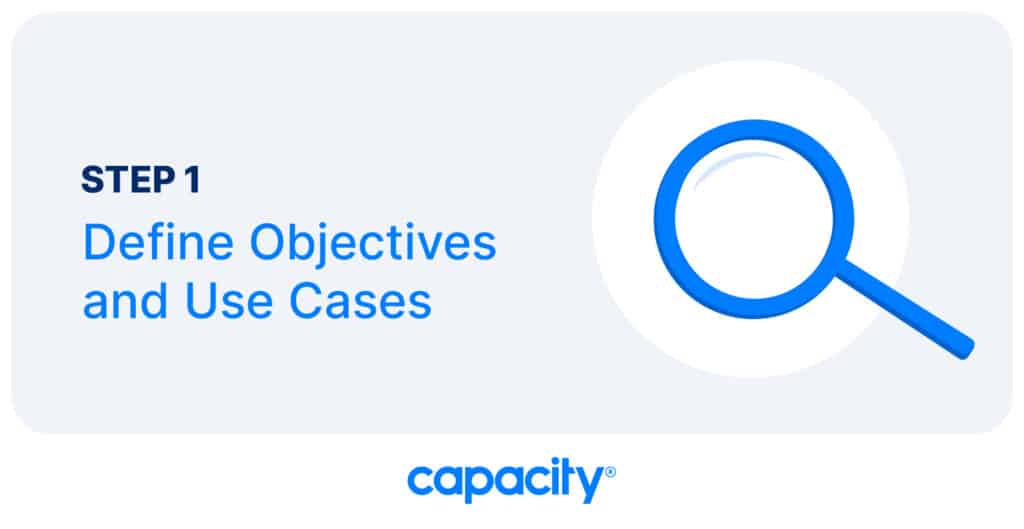
Step 1: Define Objectives and Use Cases
Before diving into building an AI chatbot, defining your objectives and use cases is crucial. Answer these questions:
- What are the specific goals you want to achieve with the chatbot?
- Do you want to provide customer support, generate leads, or automate specific processes?
- What tasks do you spend the most time working on?
Understanding your objectives will help you determine the functionalities and features you need in your chatbot. You also need to identify the use cases where the chatbot will be used.
Some use cases could include:
- Assist with product inquiries
- Answer FAQs about your business
- Reset user passwords or account information
- Automate meeting scheduling
- Engage with customers on social media such as Facebook Messenger
- Answer questions related to order tracking or troubleshooting
Defining your objectives and use cases will provide a solid foundation for building an effective AI chatbot.

Step 2: Choose the Right AI Chatbot Platform
Selecting the right AI chatbot platform is crucial to the success of your implementation. Numerous chatbot platforms are available in the market, each with its features, capabilities, and pricing models. Hint: We list a few of the best ones down below!
When choosing a platform, consider factors such as:
- Ease of use
- Customization options
- Integration capabilities
- Natural language processing capabilities
- Scalability

Step 3: Design Conversational Flows
Once you have selected an AI chatbot online platform, the next step is to design the conversational flows for your chatbot. Conversational flows define how the chatbot interacts with users, the questions it asks, and the responses it provides.
Creating a conversation flow that is intuitive, user-friendly, and aligned with your business objectives is essential. Start by defining the main menu options or intents that users can select, and then design the branching paths based on user responses.
Consider the different ways users may ask the same question and provide multiple responses to accommodate variations in user input. Keep the conversation flow concise, clear, and relevant to ensure a smooth user experience.

Step 4: Train the Chatbot with Relevant Data
Your chatbot must be trained with relevant data to understand and respond to user inquiries accurately. Most AI chatbot platforms provide tools for teaching the chatbot with datasets, such as past customer interactions, frequently asked questions, and product information.
The chatbot uses this data to learn patterns and trends and to improve its natural language processing capabilities. It’s crucial to continuously update and refine the training data to ensure the chatbot’s responses are up-to-date and relevant. Regularly review the chatbot’s performance, analyze user interactions, and make necessary adjustments to improve its accuracy and effectiveness.
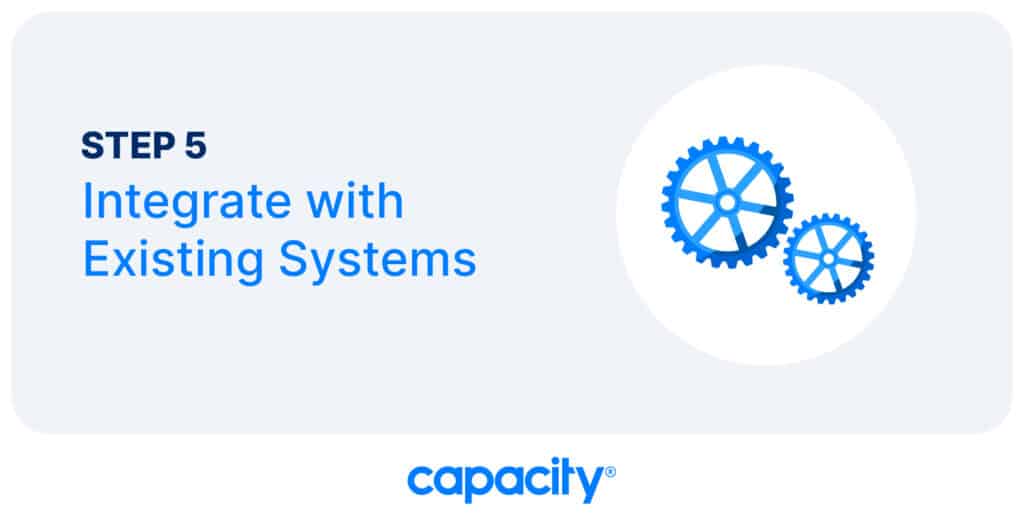
Step 5: Integrate with Existing Systems
To fully use the capabilities of your AI chatbot, it’s important to integrate it with your existing systems, such as CRM, CMS, or eCommerce platforms. Integrating with existing systems has numerous benefits:
- Enhanced Efficiency: Integrating an AI chatbot with existing systems streamlines business processes, eliminates manual data entry, and reduces errors, improving overall efficiency and productivity.
- Personalized User Experience: Integration of AI chatbot with existing systems allows for a customized user experience by using data to provide tailored responses and recommendations based on user preferences, interactions, or purchase history.
- Real-time Updates and Actions: AI chatbot integration with existing systems enables real-time access to information and the ability to perform actions, such as creating support tickets or processing orders, directly within the systems, saving time and effort for both users and your team.
Work closely with your IT team or chatbot platform provider to ensure seamless integration with your existing systems and processes.
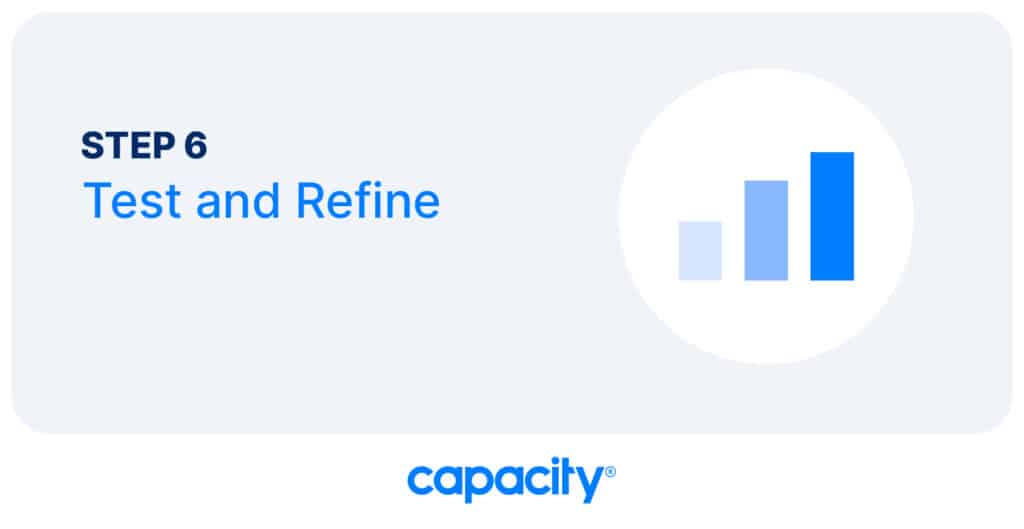
Step 6: Test and Refine
Before launching your AI chatbot online, it’s essential to thoroughly test it to ensure it’s functioning as expected. Test the chatbot with different scenarios, user inputs, and use cases to identify any issues or areas of improvement.
Gather feedback from your team and users to understand their experience and make necessary refinements. This may include tweaking the conversation flows, adjusting the training data, or fine-tuning the responses. Then, keep testing and refining until you are confident that your chatbot delivers a seamless and accurate user experience.
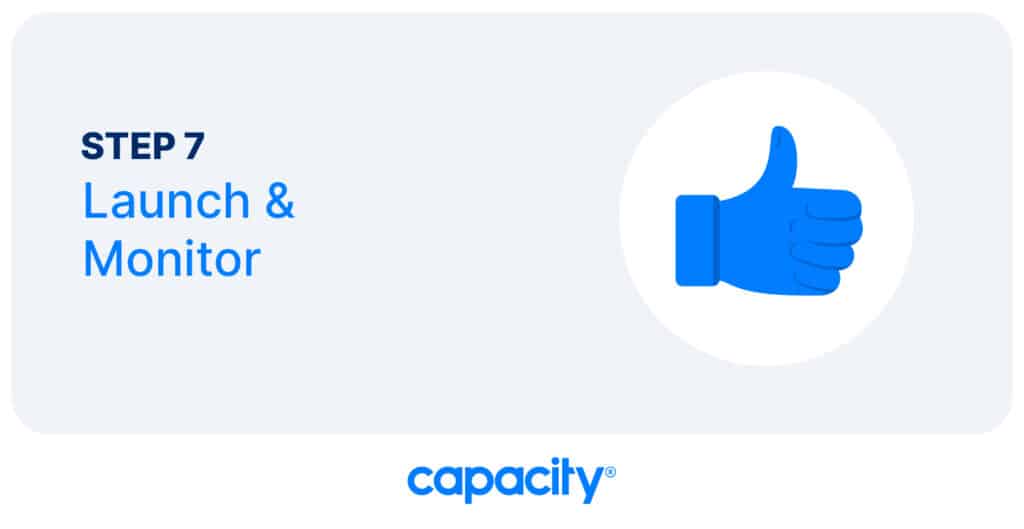
Step 7: Launch and Monitor
Once you have tested and refined your AI chatbot, it’s time to launch it online. Here are the steps:
- Deploy the chatbot on your chosen platforms, such as your website, messaging apps, or social media, and make it accessible to users.
- Promote the availability of the chatbot to your customers and ensure they know how to access and use it.
- Monitor the chatbot’s performance regularly to ensure it’s meeting your objectives and delivering value to your users.
- Use analytics and metrics your chatbot platform provides to measure the chatbot’s performance, such as user engagement, response accuracy, and completion rates.
Based on the data and insights, make adjustments to improve the chatbot’s performance and effectiveness continuously.

Automate Your Work
Capacity's enterprise AI chatbot can help:
- Answer FAQs anytime, anywhere
- Find relevant documents within seconds
- Give surveys and collect feedback
Best AI Chatbot Online Companies
Several AI chatbot online companies offer robust and reliable chatbot solutions. Here are three of the best AI chatbot online companies:
1. Capacity – Best Overall
Capacity is a comprehensive support automation platform that utilizes AI to connect all aspects of your tech stack, automating repetitive tasks and providing solutions to various business challenges.
With overwhelming questions and tasks, Capacity offers a robust solution through its low-code platform, accessible via conversational AI. It empowers teams with the following:
- Powerful Workflow Automation Suite: Capacity’s platform enables seamless automation of support and business processes through its workflow automation suite, reducing the load on your support team’s queue by answering over 90% of FAQs.
- Robust Developer Platform: With a flexible and developer-friendly platform, Capacity allows customization and deployment anywhere, providing a scalable solution tailored to your unique requirements.
- Flexible Database: Capacity’s database can be easily integrated with other apps and systems, allowing seamless data management and retrieval for efficient task execution.
Capacity’s AI-powered platform enhances productivity across cross-functional teams by automating tedious processes and tasks through low-code workflows. It also empowers employees to access information through a user-friendly knowledge base, app integrations, and conversational interfaces, resulting in a more efficient and practical support and business management system.
2. IBM Watson Assistant:
IBM Watson Assistant is a robust AI chatbot platform that harnesses the power of machine learning and natural language processing to create highly interactive conversational interfaces. It offers various tools and features to build, deploy, and manage chatbots for different channels, making it a popular choice among businesses.
Key Features:
- Customizable dialogs that allow for tailored conversations with users.
- Context-aware responses that enable the chatbot to understand and respond appropriately to user inputs.
- Seamless integration with other IBM Watson services for enhanced functionality.
- Robust analytics and reporting features for monitoring chatbot performance and user interactions.
3. Dialogflow by Google Cloud:
Dialogflow by Google Cloud is a widely used AI chatbot platform that empowers businesses to build conversational interfaces across websites, apps, and messaging platforms. With its simple tools and advanced features, Dialogflow simplifies the process of creating interactive chatbots that deliver personalized experiences to users.
Key Features:
- Intuitive tools for creating interactive dialogs and managing intents.
- Advanced features like entity recognition, sentiment analysis, and language support for building personalized chatbots.
- Seamless integration with Google Cloud services for enhanced functionality.
- Robust analytics and reporting features for monitoring chatbot performance and gaining insights into user interactions.
Try Capacity’s AI chatbot platform for free! Get started today and answer over 90% of FAQs for your business.
